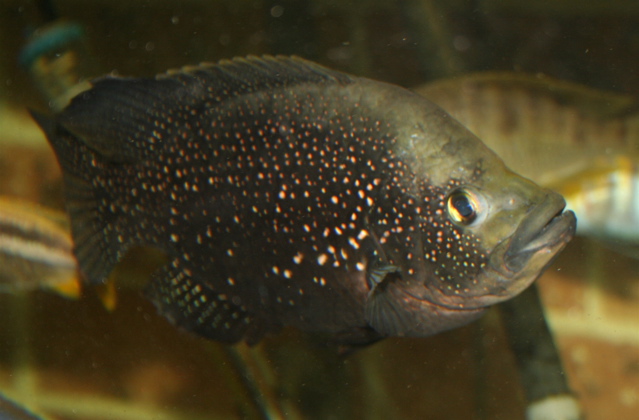- Paratilapia polleni
Taxobox
name = "Paratilapia polleni"

status = DD
status_system = IUCN3.1
regnum =Animal ia
phylum =Chordata
classis =Actinopterygii
ordo =Perciformes
familia =Cichlidae
subfamilia =Paratilapiinae
genus = "Paratilapia "
species = "P. polleni"
binomial = "Paratilapia polleni"
binomial_authority = Bleeker,1868
synonyms ="Paratilapia bleekeri" Sauvagae,1882 "Paratilapia polleni" is a medium sized
cichlid fish fromMadagascar . It was first described by the Dutchichthyologist Pieter Bleeker in 1868. In 1882, a second species, "P. bleekeri", was described, but it is now known to be ajunior synonym of "P. polleni". It is sometimes referred to by thecommon name s Polleni Cichlid and Black Diamond Cichlid, while the name Marakely ('black fish') is used among locals in Madagascar. It has a relatively small distribution and is likely to be subjected tohabitat loss , but as its actual status remains relatively poorly known, it is considered to beData Deficient byIUCN . It is found with increasing frequency in theaquarium hobby.Morphology
"P. polleni" is a laterally compressed full-bodied fish. Like most cichlids it resembles a
perch -type fish in shape, hence thetaxonomic designationperciformes - 'perch-like'. Males in captivity will develop a nuchal hump, a layer of fat above the eyes, though not to the same degree as other similar African cichlids, such as the "Cyphotilapia frontosa " andTilapia s ofAfrica .Adult "P. polleni", and sub-adult dominant individuals are jet black in color, covered with brilliantiridescent spots which shift from golden to blue depending on the movement of the fish and the angle of the light, the eye is a bright yellow. The male "P. polleni" can reach almost 30 cm (12 in) in length; females usually half that length. Sexing individuals thus becomes easier as they mature. In addition, males tend to have longer and sharper pelvic fins, and the edge of the dorsal and anal fins are often straighter in males, and more 'rounded' in females. Among aquarists it is often said that the females, though smaller are more beautiful in their coloration patterning. There are two color varieties of the "P. polleni"; the 'large spot' and the 'small spot'. Adults of both sexes display the strongest coloration during courtship and spawning. Among cichlid enthusiasts there is some confusion as to the names of these two varieties, with large spot individuals sometimes being erroneously referred to by the junior synonym "P. bleekeri". Juveniles with a length of less than 3 cm (1 in) are dull brown.Habitat and behavior
In the wild, "P. polleni" inhabits a number of rivers and associated streams in northern Madagascar, including the environs of the town of
Andapa , where most individuals exported for the aquarium trade in recent years were collected. It is anomnivorous fish and occasional opportunisticpiscivore , approaching smaller unsuspecting fish by stealth, with their dark coloration giving them an advantage. "P. polleni" observed hunting in the aquarium environment will sneak up on smaller fish from below during the pre-dawn hours and suck the smaller fish into their mouths using the typical cichlid 'suction effect' caused by quickly opening their mouths. Thus, using stealth andcrypsis they are able to prey on fish they would otherwise not be able to catch. In Madagascar, "P. polleni" is afood fish , and like many cichlid fishes in many regions, reputed to have a good flavor.In the aquarium
"P. polleni" is temperature and
pH tolerant, and reasonably hardy and not shy. As such, this fish is an ideal aquarium fish if given the appropriate environment and tank mates for a medium sized aggressive cichlid. They eat most commercial fish foods, such as flakes, pellets, frozen, and alike. "P. polleni" displays the same kind of 'intelligent' behavior common to other cichlids.Fact|date=February 2008 They can be trained to eat from the hand and will recognize and approach their owner (and often retreat from an unfamiliar person).Fact|date=February 2008 In the aquarium, "P. polleni" are more cautious and easily spooked than many of the more readily available cichlids, but otherwise adaptable to aquarium life. "P. polleni" is aggressive towards conspecifics, especially if a pair bond develops. The pair bond between males and females is sporadic and easily broken. If this happens the female can become imperiled by the male's aggression if not removed. Despite these qualities, "P. polleni" is not well known in the aquarium trade, though this is beginning to change. If they display full coloration, non-dominant and sub-dominant individuals of any size will often suffer aggression from the alpha individual(s). For this reason, there is generally only one or two fully colored individuals in an aquarium with many specimens. These traits may contribute to the relative obscurity of "P. polleni" in the hobby."P. polleni" rank among the more aggressive African cichlids, comparable to Malawi and Tilapia cichlids. Some individuals have been known to kill their tank mates upon reaching maturity, though as a rule "P. polleni" tolerates tankmates too large to eat fairly well. Successful aquarium spawnings are common.
References
* Nourissat, J. C., and P. de Rham. 2004. "The Endemic Cichlids of Madagascar." Association France Cichlid. ISBN 2951350201
* [http://cichlidae.com/gallery/species.php?s=352 "Paratilapia polleni"] - Cichlid Room. Accessed on15 February 2008 .
* [http://www.fishbase.org/Summary/speciesSummary.php?ID=8786&genusname=Paratilapia&speciesname=polleni "Paratilapia polleni"] - fishbase.org. Accessed on15 February 2008 .
* [http://www.iucnredlist.org/search/details.php/16199/all "Paratilapia polleni"] . [http://www.iucnredlist.org 2006 IUCN Red List of Threatened Species.] Accessed on15 February 2008 .
Wikimedia Foundation. 2010.
